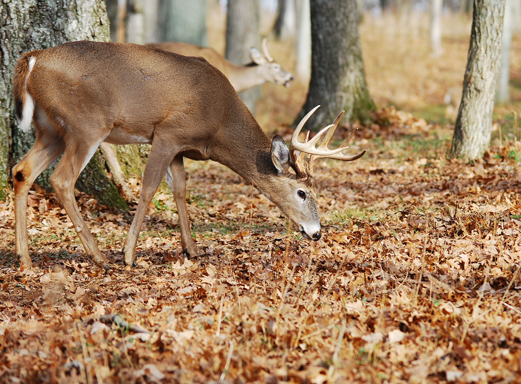
By Art Lander Jr.
FRANKFORT, Ky. – Establishing small plots of clover throughout your hunting area can pay big dividends during deer and wild turkey seasons.
Summer is a good time to start preparations for an initial planting in the fall.
“If managed correctly, stands of clover can last for three to five years without re-seeding,” said Chris Grasch, a private lands biologist who works in the Bluegrass Region for the Kentucky Department of Fish and Wildlife Resources. “Plots can be as small as ¼- to ½-acre in size and should be located where there’s full sun at least part of the day.”

Clover needs to be mowed periodically, at least once a year, and doesn’t thrive in shady areas. This perennial cool-season legume helps increase soil fertility and provides an almost year-round source of high quality forage for deer. Clover starts growing in the early spring and lasts until it is killed back by the heaviest frosts of late fall.
The first step in this habitat improvement project is to find the right area to establish a plot and prepare the soil for planting.
Secluded woods openings are especially attractive to deer because they feel safe feeding there in the late afternoons, offering good opportunities for close shots.
One option is to locate the plot at the edge of a field or existing opening that deer are already using. Make sure your tree stand or ground blind can be located within easy shooting range.
A second option, which is especially important for bow hunting deer, is creating a wildlife opening between heavy cover, where deer are known to bed, and the travel routes they take through adjacent woodlands.
Pick a level spot with decent soil fertility. Old fields covered with weeds, brush or small trees can be cleared using hand tools, a chainsaw or mower. A tiller can also be used to prepare the area for planting.
If the area is covered with fescue, Grasch recommends using herbicide to kill back the tall grass. “If the site already has some clover, there are herbicides available that will kill the fescue without harming the clover,” he said.
A chemical-free option is solarization, which uses the heat of the sun to kill the grass, vegetation or weed seeds in the soil. On a sunny summer day, place sheets of clear plastic on the ground and weigh them down with rocks on each corner. The extreme heat that develops under the plastic will kill grass and weeds down to their roots in a few days.
Conduct a soil test to measure the nutrient levels — nitrogen (N), phosphorus (P), and potassium (K) — and pH level (acidity) of the soil. Soil test kits are available at most farm stores. Follow directions carefully.
Consider using 10-10-10, a formulation commonly available in 50-pound bags, if fertilizer needs to be added to your plot. Both fertilizer and agricultural lime are available in pellet form for easy application with a hand-crank spreader.
Lime improves water penetration and the uptake of nutrients to plants growing in acidic soils.
“If fertilizer needs to be added to the site, I suggest cutting the amount in half from what is recommended for crop production,” said Grasch. “But don’t skimp on the amount of lime that is recommended; low pH is usually the issue with our soils.”
Winter wheat is a good choice for an initial planting in the fall because it’s high protein, is easily digestible by wildlife and makes a good nurse crop for clover. It grows best when the soil has a pH of 5.8 to 6.5.
“Winter wheat should be planted from Aug. 15 to Oct. 15 and you might try mixing in some clover seed,” said Grasch. “I recommend planting ladino (white) with some medium red clover.”
Clover can also be planted the following year in February or early March. Seed can be spread on a cover of light snow, or in advance of light rain or snow. The freezing and thawing action helps the seed move down into the soil so it can germinate and become established quickly.
Use these long summer days to plant a patch of clover and improve your deer hunting this fall.
-30-
The Kentucky Department of Fish and Wildlife Resources manages, regulates, enforces and promotes responsible use of all fish and wildlife species, their habitats, public wildlife areas and waterways for the benefit of those resources and for public enjoyment. Kentucky Fish and Wildlife is an agency of the Tourism, Arts and Heritage Cabinet. For more information on the department, visit our website at fw.ky.gov.


Be the first to comment